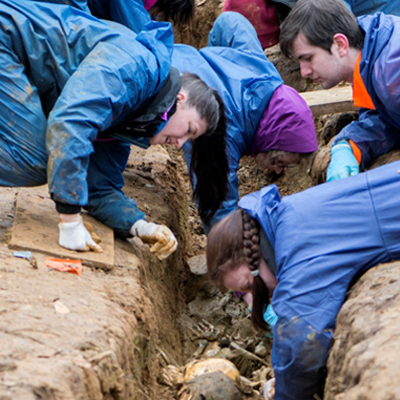Cranfield’s capabilities cover a wide range of advanced imaging and image processing techniques from the micron scale of scanning electron microscopy to landscape-scale analysis of sites of forensic and archaeological importance.
Microscopy
Cranfield’s microscopy facilities include a wide range of optical light microscopes, including comparison microscopes for ballistic analysis, stereomicroscopes, and reflected and transmitted polarizing microscopy for petrography and metallography. Scanning electron microscopy enables high resolution imaging and compositional analysis, a highly versatile technique highly suitable to the wide range of materials investigated in forensic and archaeological science.
Radiography and Micro-CT (Computed-Tomography)
CFI has the expertise to produce non-invasive 2D and 3D X-ray imaging of a range of subjects with our imaging facilities that include portable digital radiography and a number of Micro-CT units.
Radiography
Our portable digital radiography unit is capable of being operated in field conditions, making it suitable for 2D X-ray examination of subjects “in-situ”, or when transferring them to another site creates logistical problems. The equipment is suitable for examining a range of subjects including paintings, ceramics, archaeological finds, human and animal remains, industrial non-invasive testing etc. Imaging can either be undertaken at Cranfield or at any location subject to a satisfactory radiation protection survey.
Micro-CT
The facility houses two Nikon Metrology ST255 micro-CT scanners (one at each campus) that are suitable for analysis of a wide range of material and sample types, including bone, soil, ceramic and metal for a variety of applications, including ballistics, failure analysis, forensic archaeology and cultural heritage. The micro-CT collects a series of X-ray images (radiographs) of an object as it rotates through 360C, which are then digitally reconstructed to produce a 3D volume allowing visualization of the internal and external structure of the object non-destructively at a resolution of 5-137 m. The scanner is typically used to investigate samples up to 20 cm in diameter (and 12 cm in height), but can produce 2D X-radiographs of larger objects.
Object, Scene, and Landscape Imaging
CFI has advanced equipment expertise to produce non-contact three-dimensional capture of objects and landscapes. Our scanning apparatus can rapidly digitize the external surfaces of a range of environments at various scales, into 3D data. In addition to 3D visualization, this data can be transformed into physical replicas using 3D printing (rapid prototyping) or can be used for quantification.
Photography and Photogrammetry
CFI has extensive capabilities in photography, photogrammetry and other forms of 3D modelling of scenes and artefacts. This ranges from basic, high quality photography expertise and facilities for staff and student publications, via the ability to create 3D colour models using normal 2-dimensional digital photographs to scanning objects using structural light and laser scanners. While the ability to create 3D models through different techniques and hardware is an essential process, the real challenge lies in analysing 3D models. For example, CFI is working on algorithms to automatically analyse 3D bone models for biological profiling, improving result accuracy and eliminating intra- and inter-observer errors.
Surveying and Spatial Analysis
Surveying crime and incident scenes is an essential task in forensics and archaeology. CFI uses a variety of surveying techniques to document both indoor and outdoor scenes, ranging from manual surveying, airborne photogrammetry via unmanned aerial vehicles (drones), laser scanning and electronic surveying using GNSS and total station hardware. For example, aerial survey can produce high resolution digital elevation models and orthophotos to identify subtle topographic features that are sometimes undetectable at ground level, from recent burials to ancient settlements. Our geophysical survey capabilities can image sub-surface features such as graves and buried architecture.
Points of Contact
Microscopy: Jonathan Painter (Shrivenham) and Nathaniel Erb-Satullo (Cranfield Campus)
Radiography and Tomography: Mark Viner (Radiography) and Fiona Brock (Tomography)
3D Surface Imaging: Roland Wessling
Photography and Photogrammetry: Roland Wessling
Surveying and Spatial Analysis: Peter Masters



